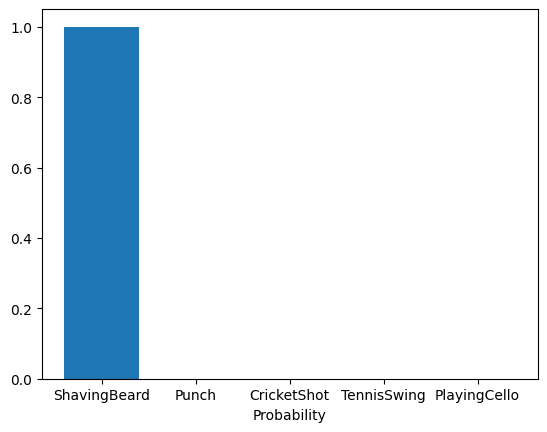트랜스포머를 사용한 비디오 분류
- 원본 링크 : https://keras.io/examples/vision/video_transformers/
- 최종 확인 : 2024-11-21
저자 : Sayak Paul
생성일 : 2021/08/06
최종 편집일 : 2023/07/22
설명 : Training a video classifier with hybrid transformers.
This example is a follow-up to the Video Classification with a CNN-RNN Architecture example. This time, we will be using a Transformer-based model (Vaswani et al.) to classify videos. You can follow this book chapter in case you need an introduction to Transformers (with code). After reading this example, you will know how to develop hybrid Transformer-based models for video classification that operate on CNN feature maps.
!pip install -q git+https://github.com/tensorflow/docsData collection
As done in the predecessor to this example, we will be using a subsampled version of the UCF101 dataset, a well-known benchmark dataset. In case you want to operate on a larger subsample or even the entire dataset, please refer to this notebook.
!wget -q https://github.com/sayakpaul/Action-Recognition-in-TensorFlow/releases/download/v1.0.0/ucf101_top5.tar.gz
!tar -xf ucf101_top5.tar.gzSetup
import os
import keras
from keras import layers
from keras.applications.densenet import DenseNet121
from tensorflow_docs.vis import embed
import matplotlib.pyplot as plt
import pandas as pd
import numpy as np
import imageio
import cv2Define hyperparameters
MAX_SEQ_LENGTH = 20
NUM_FEATURES = 1024
IMG_SIZE = 128
EPOCHS = 5Data preparation
We will mostly be following the same data preparation steps in this example, except for the following changes:
- We reduce the image size to 128x128 instead of 224x224 to speed up computation.
- Instead of using a pre-trained InceptionV3 network, we use a pre-trained DenseNet121 for feature extraction.
- We directly pad shorter videos to length
MAX_SEQ_LENGTH.
First, let’s load up the DataFrames.
train_df = pd.read_csv("train.csv")
test_df = pd.read_csv("test.csv")
print(f"Total videos for training: {len(train_df)}")
print(f"Total videos for testing: {len(test_df)}")
center_crop_layer = layers.CenterCrop(IMG_SIZE, IMG_SIZE)
def crop_center(frame):
cropped = center_crop_layer(frame[None, ...])
cropped = keras.ops.convert_to_numpy(cropped)
cropped = keras.ops.squeeze(cropped)
return cropped
# Following method is modified from this tutorial:
# https://www.tensorflow.org/hub/tutorials/action_recognition_with_tf_hub
def load_video(path, max_frames=0, offload_to_cpu=False):
cap = cv2.VideoCapture(path)
frames = []
try:
while True:
ret, frame = cap.read()
if not ret:
break
frame = frame[:, :, [2, 1, 0]]
frame = crop_center(frame)
if offload_to_cpu and keras.backend.backend() == "torch":
frame = frame.to("cpu")
frames.append(frame)
if len(frames) == max_frames:
break
finally:
cap.release()
if offload_to_cpu and keras.backend.backend() == "torch":
return np.array([frame.to("cpu").numpy() for frame in frames])
return np.array(frames)
def build_feature_extractor():
feature_extractor = DenseNet121(
weights="imagenet",
include_top=False,
pooling="avg",
input_shape=(IMG_SIZE, IMG_SIZE, 3),
)
preprocess_input = keras.applications.densenet.preprocess_input
inputs = keras.Input((IMG_SIZE, IMG_SIZE, 3))
preprocessed = preprocess_input(inputs)
outputs = feature_extractor(preprocessed)
return keras.Model(inputs, outputs, name="feature_extractor")
feature_extractor = build_feature_extractor()
# Label preprocessing with StringLookup.
label_processor = keras.layers.StringLookup(
num_oov_indices=0, vocabulary=np.unique(train_df["tag"]), mask_token=None
)
print(label_processor.get_vocabulary())
def prepare_all_videos(df, root_dir):
num_samples = len(df)
video_paths = df["video_name"].values.tolist()
labels = df["tag"].values
labels = label_processor(labels[..., None]).numpy()
# `frame_features` are what we will feed to our sequence model.
frame_features = np.zeros(
shape=(num_samples, MAX_SEQ_LENGTH, NUM_FEATURES), dtype="float32"
)
# For each video.
for idx, path in enumerate(video_paths):
# Gather all its frames and add a batch dimension.
frames = load_video(os.path.join(root_dir, path))
# Pad shorter videos.
if len(frames) < MAX_SEQ_LENGTH:
diff = MAX_SEQ_LENGTH - len(frames)
padding = np.zeros((diff, IMG_SIZE, IMG_SIZE, 3))
frames = np.concatenate(frames, padding)
frames = frames[None, ...]
# Initialize placeholder to store the features of the current video.
temp_frame_features = np.zeros(
shape=(1, MAX_SEQ_LENGTH, NUM_FEATURES), dtype="float32"
)
# Extract features from the frames of the current video.
for i, batch in enumerate(frames):
video_length = batch.shape[0]
length = min(MAX_SEQ_LENGTH, video_length)
for j in range(length):
if np.mean(batch[j, :]) > 0.0:
temp_frame_features[i, j, :] = feature_extractor.predict(
batch[None, j, :]
)
else:
temp_frame_features[i, j, :] = 0.0
frame_features[idx,] = temp_frame_features.squeeze()
return frame_features, labels결과
Total videos for training: 594
Total videos for testing: 224
['CricketShot', 'PlayingCello', 'Punch', 'ShavingBeard', 'TennisSwing']Calling prepare_all_videos() on train_df and test_df takes ~20 minutes to complete. For this reason, to save time, here we download already preprocessed NumPy arrays:
!!wget -q https://git.io/JZmf4 -O top5_data_prepared.tar.gz
!!tar -xf top5_data_prepared.tar.gztrain_data, train_labels = np.load("train_data.npy"), np.load("train_labels.npy")
test_data, test_labels = np.load("test_data.npy"), np.load("test_labels.npy")
print(f"Frame features in train set: {train_data.shape}")결과
[]
Frame features in train set: (594, 20, 1024)Building the Transformer-based model
We will be building on top of the code shared in this book chapter of Deep Learning with Python (Second ed.) by François Chollet.
First, self-attention layers that form the basic blocks of a Transformer are order-agnostic. Since videos are ordered sequences of frames, we need our Transformer model to take into account order information. We do this via positional encoding. We simply embed the positions of the frames present inside videos with an Embedding layer. We then add these positional embeddings to the precomputed CNN feature maps.
class PositionalEmbedding(layers.Layer):
def __init__(self, sequence_length, output_dim, **kwargs):
super().__init__(**kwargs)
self.position_embeddings = layers.Embedding(
input_dim=sequence_length, output_dim=output_dim
)
self.sequence_length = sequence_length
self.output_dim = output_dim
def build(self, input_shape):
self.position_embeddings.build(input_shape)
def call(self, inputs):
# The inputs are of shape: `(batch_size, frames, num_features)`
inputs = keras.ops.cast(inputs, self.compute_dtype)
length = keras.ops.shape(inputs)[1]
positions = keras.ops.arange(start=0, stop=length, step=1)
embedded_positions = self.position_embeddings(positions)
return inputs + embedded_positionsNow, we can create a subclassed layer for the Transformer.
class TransformerEncoder(layers.Layer):
def __init__(self, embed_dim, dense_dim, num_heads, **kwargs):
super().__init__(**kwargs)
self.embed_dim = embed_dim
self.dense_dim = dense_dim
self.num_heads = num_heads
self.attention = layers.MultiHeadAttention(
num_heads=num_heads, key_dim=embed_dim, dropout=0.3
)
self.dense_proj = keras.Sequential(
[
layers.Dense(dense_dim, activation=keras.activations.gelu),
layers.Dense(embed_dim),
]
)
self.layernorm_1 = layers.LayerNormalization()
self.layernorm_2 = layers.LayerNormalization()
def call(self, inputs, mask=None):
attention_output = self.attention(inputs, inputs, attention_mask=mask)
proj_input = self.layernorm_1(inputs + attention_output)
proj_output = self.dense_proj(proj_input)
return self.layernorm_2(proj_input + proj_output)Utility functions for training
def get_compiled_model(shape):
sequence_length = MAX_SEQ_LENGTH
embed_dim = NUM_FEATURES
dense_dim = 4
num_heads = 1
classes = len(label_processor.get_vocabulary())
inputs = keras.Input(shape=shape)
x = PositionalEmbedding(
sequence_length, embed_dim, name="frame_position_embedding"
)(inputs)
x = TransformerEncoder(embed_dim, dense_dim, num_heads, name="transformer_layer")(x)
x = layers.GlobalMaxPooling1D()(x)
x = layers.Dropout(0.5)(x)
outputs = layers.Dense(classes, activation="softmax")(x)
model = keras.Model(inputs, outputs)
model.compile(
optimizer="adam",
loss="sparse_categorical_crossentropy",
metrics=["accuracy"],
)
return model
def run_experiment():
filepath = "/tmp/video_classifier.weights.h5"
checkpoint = keras.callbacks.ModelCheckpoint(
filepath, save_weights_only=True, save_best_only=True, verbose=1
)
model = get_compiled_model(train_data.shape[1:])
history = model.fit(
train_data,
train_labels,
validation_split=0.15,
epochs=EPOCHS,
callbacks=[checkpoint],
)
model.load_weights(filepath)
_, accuracy = model.evaluate(test_data, test_labels)
print(f"Test accuracy: {round(accuracy * 100, 2)}%")
return modelModel training and inference
trained_model = run_experiment()결과
Epoch 1/5
16/16 ━━━━━━━━━━━━━━━━━━━━ 0s 160ms/step - accuracy: 0.5286 - loss: 2.6762
Epoch 1: val_loss improved from inf to 7.75026, saving model to /tmp/video_classifier.weights.h5
16/16 ━━━━━━━━━━━━━━━━━━━━ 7s 272ms/step - accuracy: 0.5387 - loss: 2.6139 - val_accuracy: 0.0000e+00 - val_loss: 7.7503
Epoch 2/5
15/16 ━━━━━━━━━━━━━━━━━━[37m━━ 0s 4ms/step - accuracy: 0.9396 - loss: 0.2264
Epoch 2: val_loss improved from 7.75026 to 1.96635, saving model to /tmp/video_classifier.weights.h5
16/16 ━━━━━━━━━━━━━━━━━━━━ 0s 20ms/step - accuracy: 0.9406 - loss: 0.2186 - val_accuracy: 0.4000 - val_loss: 1.9664
Epoch 3/5
14/16 ━━━━━━━━━━━━━━━━━[37m━━━ 0s 4ms/step - accuracy: 0.9823 - loss: 0.0384
Epoch 3: val_loss did not improve from 1.96635
16/16 ━━━━━━━━━━━━━━━━━━━━ 0s 5ms/step - accuracy: 0.9822 - loss: 0.0391 - val_accuracy: 0.3667 - val_loss: 3.7076
Epoch 4/5
15/16 ━━━━━━━━━━━━━━━━━━[37m━━ 0s 4ms/step - accuracy: 0.9825 - loss: 0.0681
Epoch 4: val_loss did not improve from 1.96635
16/16 ━━━━━━━━━━━━━━━━━━━━ 0s 5ms/step - accuracy: 0.9831 - loss: 0.0674 - val_accuracy: 0.4222 - val_loss: 3.7957
Epoch 5/5
15/16 ━━━━━━━━━━━━━━━━━━[37m━━ 0s 4ms/step - accuracy: 1.0000 - loss: 0.0035
Epoch 5: val_loss improved from 1.96635 to 1.56071, saving model to /tmp/video_classifier.weights.h5
16/16 ━━━━━━━━━━━━━━━━━━━━ 0s 15ms/step - accuracy: 1.0000 - loss: 0.0033 - val_accuracy: 0.6333 - val_loss: 1.5607
7/7 ━━━━━━━━━━━━━━━━━━━━ 0s 3ms/step - accuracy: 0.9286 - loss: 0.4434
Test accuracy: 89.29%Note: This model has ~4.23 Million parameters, which is way more than the sequence model (99918 parameters) we used in the prequel of this example. This kind of Transformer model works best with a larger dataset and a longer pre-training schedule.
def prepare_single_video(frames):
frame_features = np.zeros(shape=(1, MAX_SEQ_LENGTH, NUM_FEATURES), dtype="float32")
# Pad shorter videos.
if len(frames) < MAX_SEQ_LENGTH:
diff = MAX_SEQ_LENGTH - len(frames)
padding = np.zeros((diff, IMG_SIZE, IMG_SIZE, 3))
frames = np.concatenate(frames, padding)
frames = frames[None, ...]
# Extract features from the frames of the current video.
for i, batch in enumerate(frames):
video_length = batch.shape[0]
length = min(MAX_SEQ_LENGTH, video_length)
for j in range(length):
if np.mean(batch[j, :]) > 0.0:
frame_features[i, j, :] = feature_extractor.predict(batch[None, j, :])
else:
frame_features[i, j, :] = 0.0
return frame_features
def predict_action(path):
class_vocab = label_processor.get_vocabulary()
frames = load_video(os.path.join("test", path), offload_to_cpu=True)
frame_features = prepare_single_video(frames)
probabilities = trained_model.predict(frame_features)[0]
plot_x_axis, plot_y_axis = [], []
for i in np.argsort(probabilities)[::-1]:
plot_x_axis.append(class_vocab[i])
plot_y_axis.append(probabilities[i])
print(f" {class_vocab[i]}: {probabilities[i] * 100:5.2f}%")
plt.bar(plot_x_axis, plot_y_axis, label=plot_x_axis)
plt.xlabel("class_label")
plt.xlabel("Probability")
plt.show()
return frames
# This utility is for visualization.
# Referenced from:
# https://www.tensorflow.org/hub/tutorials/action_recognition_with_tf_hub
def to_gif(images):
converted_images = images.astype(np.uint8)
imageio.mimsave("animation.gif", converted_images, fps=10)
return embed.embed_file("animation.gif")
test_video = np.random.choice(test_df["video_name"].values.tolist())
print(f"Test video path: {test_video}")
test_frames = predict_action(test_video)
to_gif(test_frames[:MAX_SEQ_LENGTH])결과
Test video path: v_ShavingBeard_g03_c02.avi
1/1 ━━━━━━━━━━━━━━━━━━━━ 20s 20s/step
1/1 ━━━━━━━━━━━━━━━━━━━━ 0s 9ms/step
1/1 ━━━━━━━━━━━━━━━━━━━━ 0s 8ms/step
1/1 ━━━━━━━━━━━━━━━━━━━━ 0s 8ms/step
1/1 ━━━━━━━━━━━━━━━━━━━━ 0s 9ms/step
1/1 ━━━━━━━━━━━━━━━━━━━━ 0s 8ms/step
1/1 ━━━━━━━━━━━━━━━━━━━━ 0s 8ms/step
1/1 ━━━━━━━━━━━━━━━━━━━━ 0s 9ms/step
1/1 ━━━━━━━━━━━━━━━━━━━━ 0s 9ms/step
1/1 ━━━━━━━━━━━━━━━━━━━━ 0s 10ms/step
1/1 ━━━━━━━━━━━━━━━━━━━━ 0s 11ms/step
1/1 ━━━━━━━━━━━━━━━━━━━━ 0s 12ms/step
1/1 ━━━━━━━━━━━━━━━━━━━━ 0s 12ms/step
1/1 ━━━━━━━━━━━━━━━━━━━━ 0s 9ms/step
1/1 ━━━━━━━━━━━━━━━━━━━━ 0s 9ms/step
1/1 ━━━━━━━━━━━━━━━━━━━━ 0s 9ms/step
1/1 ━━━━━━━━━━━━━━━━━━━━ 0s 9ms/step
1/1 ━━━━━━━━━━━━━━━━━━━━ 0s 9ms/step
1/1 ━━━━━━━━━━━━━━━━━━━━ 0s 9ms/step
1/1 ━━━━━━━━━━━━━━━━━━━━ 0s 9ms/step
1/1 ━━━━━━━━━━━━━━━━━━━━ 1s 557ms/step
ShavingBeard: 100.00%
Punch: 0.00%
CricketShot: 0.00%
TennisSwing: 0.00%
PlayingCello: 0.00%

The performance of our model is far from optimal, because it was trained on a small dataset.